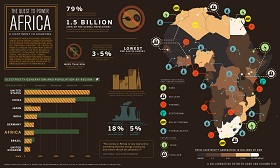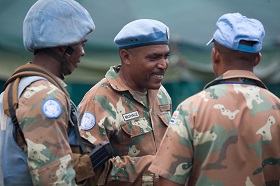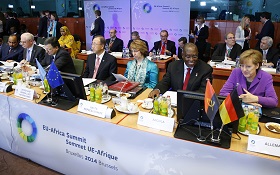United Africa?
(no votes) |
(0 votes) |
Doctor of History, Professor, Chief Researcher at the RAS Institute of African Studies
In 2013, Africa celebrated the golden jubilee of its continental organization – the Organization of African Unity, which in 2002 was reorganized into the African Union. To what extent has the dream of its “founding fathers” to unite Africa become a reality? How many more years will it take for this to come true, or is it time to admit that achieving unity is no different from chasing a rainbow?
From the OAU to the AU
The predecessor of the African Union has done much to eliminate the colonial and racist regimes on the continent, primarily through the Liberation Committee that rendered not only political but also practical support to national liberation movements waging armed struggles. The members of the AU are all countries located on the continent, with the exception of Morocco, which formally withdrew from the OAU due to the admission of the Sahrawi Arab Democratic Republic (SADR) as a full member of the organization (SADR claims sovereignty over the Western Sahara territory, which Morocco claims as its own).
There is much continuity between the OAU Charter and the Constitutive Act of the AU as well as several differences between the new organization and its predecessor. One example is the clause condemning and refusing to recognize governments that have come to power through unconstitutional means; this feature is a fundamentally new attribute of the AU Constitutive Act. This provision is theoretically been observed, but in practice some governments have tended to acquire “legitimacy” after conducting “democratization” exercises. Egypt is the latest example of this. After being suspended in the wake of the removal of former President Mohamed Morsi, the country was reinstated to the African Union at the AU summit held in late June 2014 in the capital of Equatorial Guinea, Malabo ().
The Constitutive Act emphasizes not only “sovereign equality”, but also "the interdependence of Member States of the Union", as well as provides for “the right of Member States to request intervention from the Union in order to restore peace and security”. Moreover, the Union has the right to direct interventions (including those military in nature) in Member States pursuant to a decision made by the Assembly of Heads of State and Government and affirmed by a two-thirds vote, but only during extenuating circumstances, namely: war crimes, genocide and crimes against humanity. However, over the past 12 years, this provision of the AU Constitutive Act has never been applied, and African leaders prefer to adopt decisions by consensus.
Significant changes have occurred in the organizational structures of the continent-wide union. In a similar fashion to the European Union, its supreme executive body is called the AU Commission, while was once referred to as the General Secretariat in the OAU. The AU was created as a more democratic structure, and over the past ten years several official bodies have come into being, such as the Pan-African Parliament and Economic, Social and Cultural Council, which represent civil society and the African diaspora respectively.[1]
New Frontiers
The new functions of the AU were established during its jubilee celebration and concurrent working assemblies held on May 25-26, 2013 in Addis Ababa. The theme adopted for the Golden Jubilee celebration of the OAU-AU was “Pan-Africanism and African Renaissance.” The official press release for the Summit emphasized that “the 50th anniversary comes at a golden time for Africa as the continent, which was perceived a decade ago as hopeless, is now unequivocally on the rise.” Specific figures were cited to substantiate the progress made. According to Carlos Lopes, Executive Secretary of the UN Economic Commission for Africa, the continent maintained an average GDP growth rate of 5 percent, which was higher than the average global rate. But at the same time, the pre-summit slogan “An Integrated, Prosperous and Peaceful Africa by 2063,” posted in boardrooms and on the streets of Addis Ababa, displayed a sense of realism, since Africans were called upon to achieve unity, prosperity and peace on the continent over the next half century when the centennial jubilee would be celebrated.
In contrast to discussions some years ago over the establishment of a pan-African government and a set of ministerial positions, the emphasis is now being placed on economic integration, based on strengthening existing regional communities.
It should be noted that the current assessment of the prospects of African integration has become more realistic. In contrast to discussions some years ago over the establishment of a pan-African government and a set of ministerial positions, the emphasis is now being placed on economic integration, based on strengthening existing regional communities.[2]
The African Union Commission’s Strategic Plan for 2014-2017, adopted by the Assembly, identifies eight priority areas:
1. Human capacity development focusing on health, education, science, research, technology and innovation;
2. Agriculture and agro-processing;[3]
3. Inclusive economic development through industrialization, infrastructure development, agriculture and trade and investment;
4. Peace, stability and good governance;
5. Incorporating women and youth into all activities;
6. Resource mobilization;
7. Building a people-centered Union through active communication and branding; and
8. Strengthening the institutional capacity of the Union and all of its organs.(.).
Problems and Solutions
After becoming elected by the African Union Commission as its Chairperson a year and a half ago, Dr. Nkosazana Clarice Dlamini-Zuma,[4] who had previously occupied a number of ministerial posts in South Africa, rightly pointed out that Africa had to answer a lot of “tough questions.” Such questions concern the activities of the AU and its bodies too. The lack of political will to implement decisions, caused by a reluctance of leaders of the AU member-states to cede partial national authority is definitely one of the major problems facing the continent-wide organization today (and, in many ways, this has been inherited from the OAU). As a rule, it has taken several years to ratify documents to establish continent-wide structures. Another “misfortune” appears to be the continued failure of most countries to pay their membership dues, which has forced the African Union and a number of its members to depend on external donors, mainly NATO countries and China (the latter provides about 20 percent of donor assistance to the Union). This dependence restricts their freedom of action. Donors cover almost 60 percent of the AU budget () and nine-tenths of the budget for peacekeeping operations.[5] By the beginning of 2014, only 16 of the 54 Member States had fulfilled their dues to the Union budget. It should be noted that five countries – South Africa, Egypt, Nigeria, Algeria and Libya – each contribute 13.37 percent of the AU budget, making the share of the other 49 countries only a third of the budget[6] (Ibid). The main reason for non-payment is not the lack of funds, but again the lack of political will.
The very existence of the AU and its regional communities has considerably strengthened Africans’ position in the face of the new challenges of the 21st century.
Nevertheless, we can speak of certain AU achievements too, in particular in the sphere of economic integration. Gone are the days when telephone and air communications between various regions of Africa were carried out as a rule through former imperial masters. Regional free trade areas and customs unions are being established (or have already been created). The decision of the leaders of three African trading blocs to create a free trade zone of 26 countries from Libya to South Africa appears to be the most important in this regard. It is assumed that other regional communities will join it and a continent-wide free trade zone is expected to be operational by 2018.
However, it would be wrong to consider the issue of integration in Africa just as an interstate one. Many quangos – quasi-autonomous non-governmental organizations - have appeared on the continent, which often develop at a quicker pace than official structures. So, although the AU Constitutive Act provides for the establishment of an African Central Bank, an African Investment Bank and an African Monetary Fund, these institutions have not yet been created (aside from technical preparatory committees). However, nearly two dozen quangos already exist, which at a minimum are partially carrying out the functions of these bodies and promoting African integration.
In the sphere of finance, examples of quangos include the African Development Bank (headquartered in Tunis), the African Export-Import Bank (headquartered in Cairo), and the Development Bank of Southern Africa (headquartered in Pretoria), which operates, despite the name, across the entire continent. In the fields of transportation, communications and energy, the African Civil Aviation Commission, the African Railway Union, the Pan-African Telecommunications Union, and the African Energy Commission are all operating. Similar organizations exist in the fields of science and technology. Existing business and civil society structures are promoting cooperation among various countries from the continent.
As for regional intergovernmental organizations, the Union has officially recognized eight.[7] Both the AU and these regional communities are playing an important role in peacemaking. The continent has created a structure called the African Peace and Security Architecture (APSA) that includes, among others, the AU Peace and Security Council and the African Standby Force (ASF). Back in 1995, it was decided that these should consist of five regional brigades. Although the creation of these units has taken much longer than originally planned, and the date of their official “startup” has been postponed until 2015, the total number of peacekeeping forces deployed in 2012 by the African Union or regional organizations into conflict areas exceeded the planned ASF strength of 25 000 people.[8] The largest number of peacekeepers – over 22 thousand soldiers – is being deployed through the African Union Mission in Somalia (AMISOM); over 18 thousand are taking part in the African Union/United Nations Hybrid operation in Sudan (UNAMID).
Making Comparisons
The state and scope of activities of the AU can only be objectively evaluated with regards to the activities of similar organizations. We agree with prominent South African political scientist from the University of the Western Cape, Keith Gottschalk, who believes that the AU has “exceeded” its counterparts, namely the Association of Southeast Asian Nations (ASEAN), the Arab League, the Southern Cone Common Market (Mercosur}, the Organization of American States and the Association of Regional Cooperation in South Asia, through, for example, the operations of a common parliament and peacekeeping operations. According to K. Gottschalk, the AU is second only to the EU, whose staff is 200 times larger with a budget 400 times the size,[9] while the population of the EU member-states is twice as small as that on the African continent.
It is worth noting that a number of institutions within the framework of the AU have been established two decades earlier than had been anticipated by previous agreements. These institutions include the Pan-African Parliament (PAP) and the African Court on Human and Peoples' Rights, although their work delegates some sovereign rights to supranational organizations.
However, the conditions allowing for the functioning of these pan-African bodies at full strength have been created quite slowly. The Court was established by a Protocol adopted in 1998 and came into force only in 2004. However, only 26 countries have ratified it, while the Rules of Court were only adopted in 2010.
The PAP gained the power to discuss the AU annual budget only in 2013. The transition to the direct election of members of Parliament has been rescheduled several times. By comparison, it took the EU 20 years to achieve the same thing. Moreover, with all the generous funding and democratic traditions, it took the EU half a century to reach the current state of development and operations of its bodies (it should be noted that the number of the EU critics – Eurosceptics – is growing). The same “yardstick” should apply to the AU if its prospects are to be realistically evaluated.
In general, we can conclude that achieving unity in Africa, which was the dream of the leader of independent Ghana Kwame Nkrumah more than half a century ago, and which was vigorously promoted by Muammar Gaddafi during this century, is a long and very complicated process. Along with these aspirations, the very existence of the AU and its regional communities has considerably strengthened Africans’ position in the face of the new challenges of the 21st century. Those who try to impose a new world order have to contend with the fact that African countries make up more than a quarter of UN members, let alone the growing importance of the continent as a source of valuable raw materials and labor. While the level of dependency in developed countries is on the rise, due to the enlarging and aging populations, in African countries the “demographic dividend” should peak in about 30-40 years, when Africa will account for 65 percent of international labor force growth. Globalization will accelerate economic development and promote the economic rise of the continent as a whole. (I.O Abaramova. The Role of “Demographic Dividend” in World Development) Africa’s success in taking advantage of these new opportunities depends largely on the degree of unity within the African Union.
[1] The First Assembly of the Council was held in 2008, but it has actually not functioned effectively since. The convening of the Second Assembly has repeatedly been postponed, due to the paradoxically weak interest displayed by civil society organizations.
[2] In his speech at the celebration, Prime Minister of Ethiopia Hailemariam Desalegn, who was Chairman of the AU, spoke about Africa in 50 years only as “economically integrated”, while President of Uganda Yoweri Museveni bluntly disagreed with the idea of the political integration of the continent advanced by M. Gaddafi, and called plans for more realistic regional integration (the author was present at the meeting and witnessed this exchange of opinions personally). However, we know from personal experience how difficult it is to address the issues of political integration – the idea of the Eurasian Union has so far been realized only in the form of economic integration.
[3] Incidentally, agriculture and food security were the main issues of the AU summit, held in late June 2014.
[4] It’s interesting to note, that after the election of the new Chairperson of the AU Commission, discipline has been strengthened. The author has witnessed discussions involving the participation of the Heads of State and Government, when the microphone was automatically disconnected after the three minutes allotted for each speech had expired.
[5] Keith Gottschalk. 13th Conference of Africanists. Moscow 2014. 50 Years of the OAU-AU & their Sub-Regional Affiliates p.8.
[6] Following the overthrow of M. Gaddafi, Libya’s debt in January 2014 amounted to 16 million dollars.
[7] The Community of Sahel-Saharan States (CEN-SAD), the Common Market for Eastern and Southern Africa (COMESA), the East African Community (EAC), the Economic Community of Central African States (ECCAS), the Economic Community of West African States (ECOWAS), the Intergovernmental Authority on Development (IGAD), the Southern African Development Community (SADC), the Arab Maghreb Union (AMU). (http://www.au.int/en/)
[8] Keith Gottschalk, Op. cit. p. 8.
[9] Ibid. p. 1.
(no votes) |
(0 votes) |







